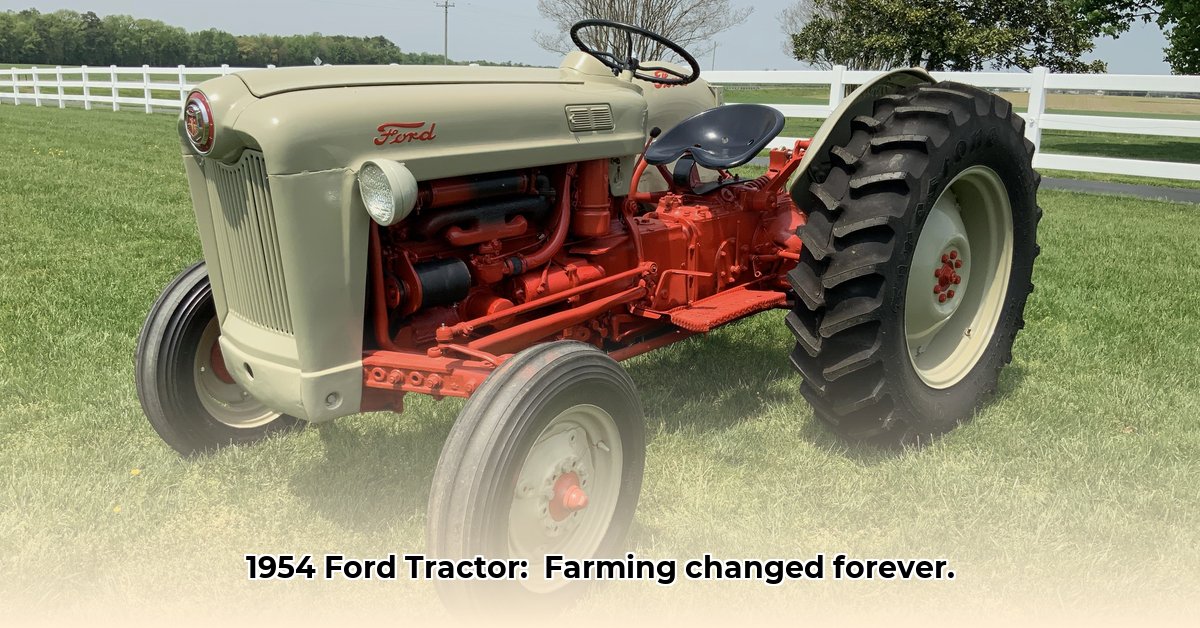
The year is 1954. Post-war America hummed with a renewed sense of optimism, and nowhere was this more evident than on the nation's farms. Farmers, weary from years of hardship, embraced a new symbol of hope: the Ford NAA tractor. More than just a machine, the NAA represented a leap forward in agricultural technology, a promise of increased efficiency, and a lighter workload. This article delves into the design, impact, and enduring legacy of this iconic tractor. For more on Ford tractor problems, see this helpful resource: Ford Tractor Problems.
The NAA's Rise to Prominence: A Horsepower Hero
Emerging from the post-war boom, the Ford NAA, with its sturdy 26.8 drawbar horsepower (the force it could exert to pull implements), represented a significant leap forward in farm mechanization. Farmers, still recovering from the hardships of earlier years, looked to this machine as a symbol of hope, promising increased efficiency and a lighter workload. Wasn't this a significant improvement over the back-breaking labor of yesteryear? The robust design translated to more crops harvested with fewer hours of toil. This wasn't just a machine; it was a promise of a better life.
Power and Performance: More Muscle Than a Mule
The NAA's 26.8 drawbar horsepower and 31.14 PTO (power take-off) horsepower were impressive for its time. This meant it could handle heavy implements like plows and harrows with ease, and power equipment like hay balers and combines. Imagine the time saved! This was a considerable increase over older models, significantly boosting overall productivity. While less powerful than modern tractors, the NAA was a workhorse, capable of handling even the most demanding field tasks. How did this impact farmers' daily lives?
Innovation on the Farm: Beyond Brute Force
The NAA's innovative features set it apart. Its hydraulic system, a relative novelty then, facilitated position and draft control, allowing for much more precise operation. The 800-pound lift capacity, while modest by today's standards, was a game-changer. Farmers could adjust implements smoothly and precisely, eliminating much of the manual adjustment needed on older machinery. This precision translated into reduced wasted effort and improved overall efficiency. Did this contribute to the superior efficacy farmers experienced?
A Look at the NAA's Limitations: Progress is a Journey
Even revolutionary machines have their drawbacks. The NAA's horsepower, while substantial for its time, pales in comparison to modern tractors. Fuel efficiency wasn’t a primary concern; consequently, gasoline consumption was likely high. This contrasts sharply with today's emphasis on sustainable agriculture, where minimizing environmental impact is paramount. What were the trade-offs inherent in the NAA's design?
The NAA's Impact and Enduring Legacy: More Than Just a Machine
The Ford 1954 NAA wasn't merely a machine; it was a symbol of hope and progress for post-war farmers. It represented a pivotal step in the mechanization of agriculture, dramatically changing farming practices. Its relatively simple design also ensured easier maintenance, a crucial benefit in rural areas where access to specialized repair shops was limited. The enduring popularity of these tractors among collectors serves as a testament to their historical significance and enduring appeal. What accounts for the NAA's enduring legacy?
Ford NAA Tractor: Weighing the Pros and Cons
| Feature | Pros | Cons |
|---|---|---|
| Power & Performance | Significantly more powerful than predecessors; boosted farm productivity. | Lower power output compared to modern tractors; less fuel-efficient than current models. |
| Technology | Introduced a hydraulic system for precise implement control & improved efficiency | Limited lift capacity & rudimentary safety features compared to modern machines. |
| Impact | Symbolized post-war agricultural progress & eased the burden of manual labor. | Had a significant environmental footprint (fuel consumption, emissions) compared to current tractors. |
| Cost | Relatively affordable for its era. | N/A |
The Ford NAA's Lasting Impression: A Piece of History
The 1954 Ford NAA tractor stands as a testament to agricultural ingenuity during a period of significant transformation. It played a vital role in mechanizing farming, easing workloads and increasing yields. While its technology may seem rudimentary today, its cultural impact and influence on farming practices remain undeniable. This machine is more than just a relic; it's a story, a symbol of human innovation, progress, and the ongoing evolution of agricultural technology. What lessons can we learn from the NAA’s design and impact?
How to Compare Ford NAA Tractor Fuel Efficiency to Modern Sustainable Farming Equipment
Key Takeaways:
- The Ford NAA offered significant advancements in efficiency for its era. Comparing its fuel consumption to modern equipment requires considering technological advancements and changing farming practices.
- Modern tractors, while offering enhanced precision, often consume more fuel due to emission control systems. This doesn't automatically equate to lower efficiency.
- Optimizing equipment, regardless of age, remains key to fuel efficiency. Proper maintenance is crucial.
- Comparing fuel efficiency necessitates analyzing fuel consumption per acre and considering operational practices.
Directly comparing the fuel efficiency of a 1954 Ford NAA to a modern tractor is complex. A more meaningful comparison involves analyzing fuel consumption per acre, factoring in operational practices, considering maintenance costs, and accounting for technological advancements in modern tractors using a Life Cycle Assessment (LCA). Ultimately, "fuel efficiency" demands a holistic perspective.